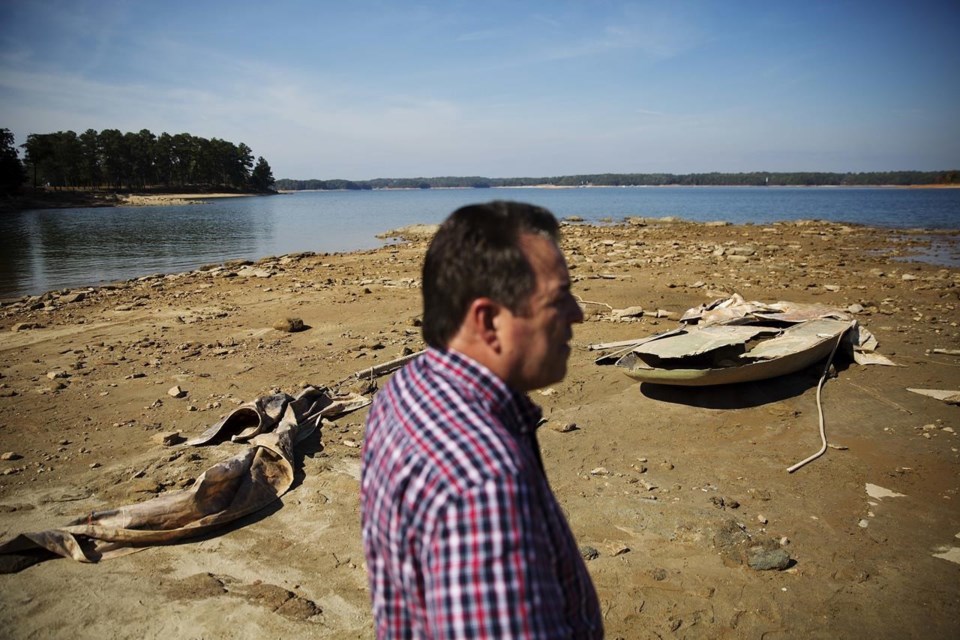is making droughts faster and more furious, especially a specific fast-developing heat-driven kind that catch farmers by surprise, a new study found.
The study in Thursday’s found droughts in general are being triggered faster. But it also showed that a special and particularly nasty sudden kind — called “flash droughts” by experts — is casting an ever bigger crop-killing footprint.
It comes only in the growing season – mostly summer, but also spring and fall – and is insidious because it’s caused not just by the lack of rain or snow that's behind a typical slow-onset drought, hydrologists and meteorologists said.
What happens is the air gets so hot and so dry that it sucks water right out of plants and soil.
“It’s the increasing thirstiness of the atmosphere,” said UCLA and National Center for Atmospheric Research climate scientist Daniel Swain, who wasn’t part of the study. Swain called the issue “very relevant in a warming climate.”
The term flash drought was coined around 2000 but it really took off sudden drought struck the central United States, one of the worst droughts since the infamous Dust Bowl devastated the Plains in the 1930s, according to the study.
“Because it occurs very, very fast people started to focus on this new phenomenon,” said study lead author Xing Yuan, dean of the School of Hydrology and Water Resources at Nanjing University of Information Science and Technology in China. “For the 2012 drought, actually the drought just developed in a very severe condition just within a month.”
Most of was struck by a flash drought that developed within only a month due to high temperatures, which also triggered wildfires, Yuan said. Parts of the river dried up and there was an energy shortage in southern China because hydropower wouldn’t work, he said.
“It developed very fast so you don’t have enough time to prepare for this drought,” Yuan said.
Another sudden drought happened in the U.S. Southeast in 2016 and was a factor in in Gatlinburg, Tennessee, said Jason Otkin, a study co-author and an atmospheric scientist at the University of Wisconsin, Madison.
The current drought in the started two years ago as a rapid onset drought, said Joel Lisonbee, a climatologist at the National Oceanic and Atmospheric Administration’s National Integrated Drought Information System in Colorado. He wasn’t part of the study but praised it, saying “essentially a warmer world allows for faster onset of drought.”
Yuan, Otkin and their research team looked back at droughts, how fast they occurred and what kind they were, across the globe since 1951 and found flash droughts are happening more often in nearly three-quarters of the climate regions of the world. They also found droughts of all kinds happening faster.
Although they couldn’t quantify how much faster because of the variability in places and times, Yuan said it would be fair to say droughts are happening weeks earlier than they once did.
Yuan said some of the bigger increases in sudden droughts have been in Europe and Australia. Outside experts pointed to the Amazon as prone to them.
“We have to pay attention to this phenomenon because it’s increasing,” Yuan said.
Yuan’s team also used computer simulations – both with worst-case warming and more moderate warming – and projected that the proportion of flash droughts will increase in a warmer world and droughts will continue to keep happening faster.
By definition, flash droughts – because they result from low soil moisture levels – are especially bad for agriculture, experts said.
The trouble is there has been an old way of thinking that “we have months or years before we need to worry about drought,” said Mark Svoboda, director of the at the University of Nebraska-Lincoln.
That’s the reason why Svoboda, who wasn’t part of this study, said he pioneered the term “flash drought’’ and wanted to “dispel the notion that droughts only manifest themselves over long period of time.”
Svoboda's agency recommends that farmers, ranchers, municipal water suppliers and hydropower plants come up with . For example, farmers and ranchers should know how susceptible they are to drought and have alternative plans for plantings or foraging.
NOAA's Lisonbee said in an email that the problem is “in a slowly evolving drought if a farmer thinks the season ahead will be dry, they may consider a more drought-tolerant crop that season, but when a flash drought occurs it is likely the crops are already in the ground and there is little that can be done.”
___
Follow AP’s climate and environment coverage at
___
Follow Seth Borenstein on Twitter at
___
Associated Press climate and environmental coverage receives support from several private foundations. See more about AP’s climate initiative . The AP is solely responsible for all content.
Seth Borenstein, The Associated Press




